About Brachiosaurus
| Scientific Name (Genus) | Brachiosaurus |
| Name Meaning |
Arm Lizard
brachiōn (arm) [Greek] - sauros (lizard) [Greek] |
| Classification | Saurischia, Sauropodomorpha (Sauropoda) |
| Total Length | Approx. 25m |
| Diet | Herbivore |
| Period | Late Jurassic - Early Cretaceous |
| Species |
Brachiosaurus altithorax
Brachiosaurus atalaiensis Brachiosaurus nougaredi |
| Year Described | 1903 |
| Publication | Riggs, E.S. (1903). Brachiosaurus altithorax, the largest known dinosaur. American Journal of Science. 4. 15. |
Characteristics - The Neck Posture Debate
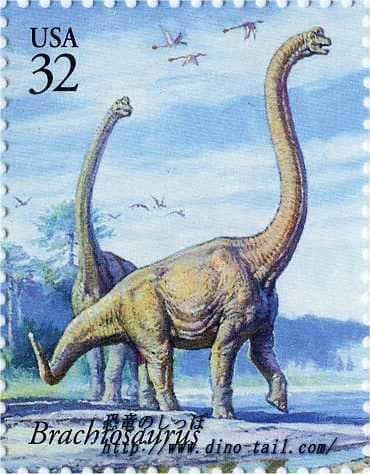
Brachiosaurus reached a length of 25 meters and a height of 16 meters when it extended its neck. Its key feature, which starkly differs from other sauropodomorphs, was that its forelimbs were longer than its hind limbs . This is thought to have allowed it to keep its head at a high position.
Brachiosaurus's teeth were shaped like pencils or spatulas, unsuitable for grinding plants. By keeping its head high, it is believed to have raked in large amounts of leaves from tall conifers, ferns, and cycads, swallowing them whole without chewing.
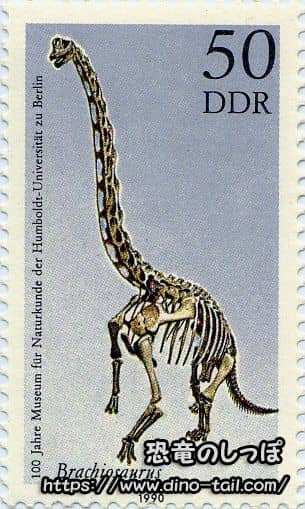
At the same time, its height posed significant challenges. It is presumed that an extremely powerful heart and high blood pressure were necessary to send blood to a brain located more than 10 meters above the ground. Also, to maintain such a huge body and remain active, the energy of a cold-blooded animal, like modern reptiles, would be insufficient. Analysis of bone internal structure suggests that Brachiosaurus might have been a warm-blooded animal with a high metabolic rate.
Brachiosaurus is iconic for its long neck held high, and for many years it was believed to have held its neck high like a giraffe to eat leaves from tall trees. This was depicted in many restorations and films.
However, recent research has cast doubt on this image.
First, from a physiological perspective, it was pointed out that an unrealistically large and powerful heart would be needed to pump blood to a brain so high up. Furthermore, detailed analysis of the neck vertebrae's joint structure suggests it might have been skeletally difficult to lift the neck to a near-vertical position.
A decisive piece of evidence in this debate came from 3D computer simulation analysis. A study published in 2005 by paleontologist Michael Parrish et al. [Neck posture, dentition, and feeding strategies in Jurassic sauropod dinosaurs.] digitally reconstructed the Brachiosaurus's neck skeleton and analyzed its range of motion. The results showed that the vertical range of motion was very limited, likely only allowing it to lift its neck about 20 degrees from the horizontal. On the other hand, it was found that the horizontal range of motion to the sides was very wide.
Based on these findings, a new posture is now proposed. The theory is that Brachiosaurus did not hold its neck high, but rather kept it at a near-horizontal angle, using its extensive side-to-side reach to efficiently eat plants over a wide area without moving its massive body. Its 16-meter height seems to have been achieved by its long, sturdy forelimbs and sloping torso, rather than a vertically extended neck.
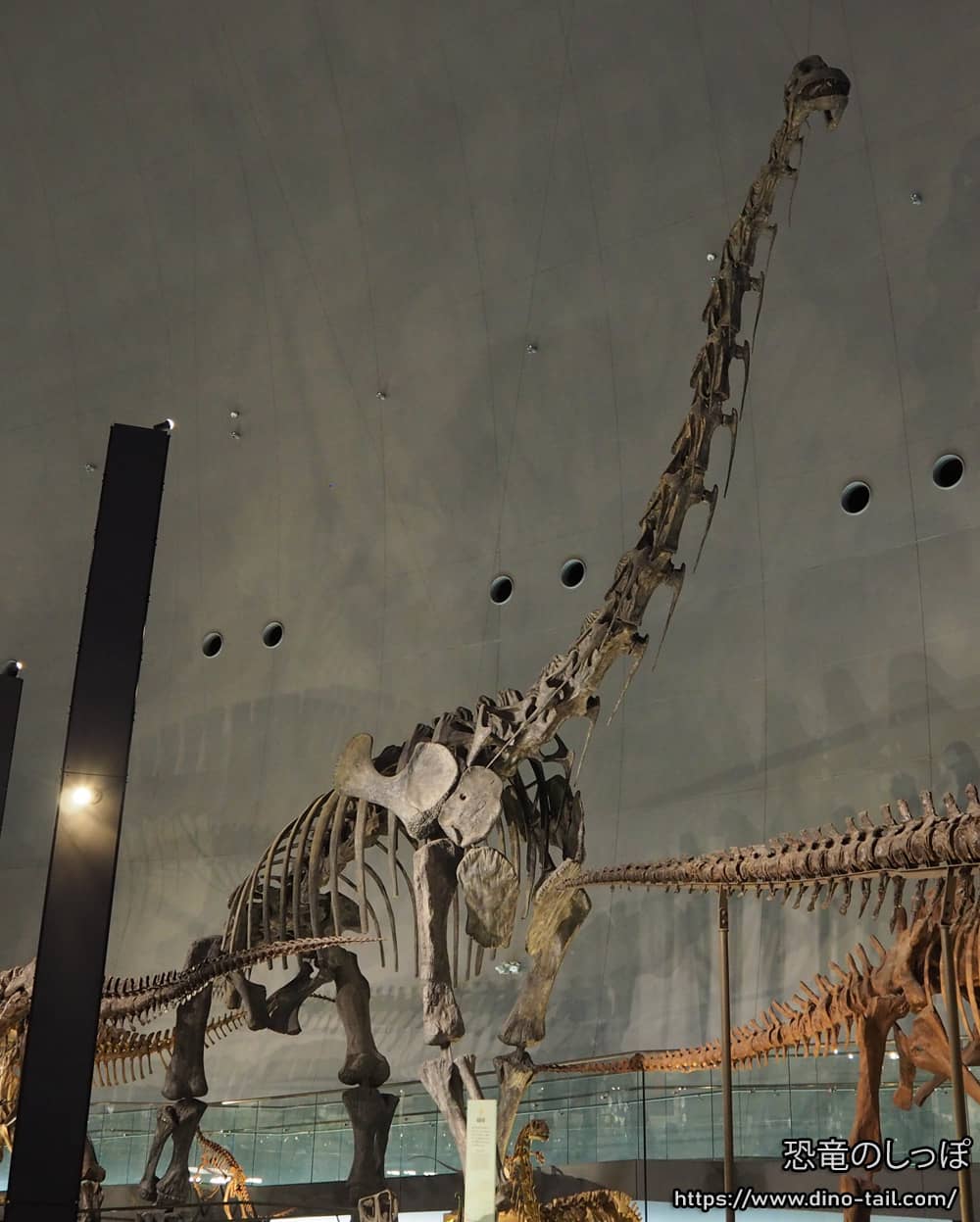
Brachiosaurus's Habitat
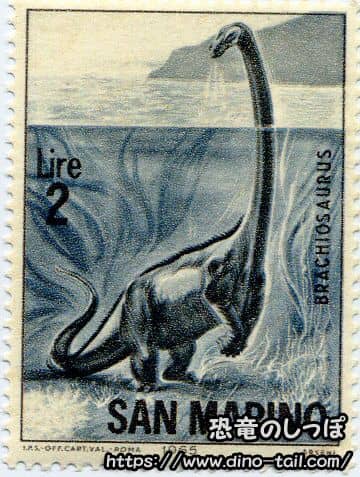
Depicted in water.
We now know this was incorrect and it lived on land.
It was once thought that "Brachiosaurus lived in water, such as swamps."
This was because its nostrils were on top of its head, and it was believed that, to support its large weight (initially estimated at 80 tons), it "used the buoyancy of water to reduce the strain of its weight, much like a modern hippopotamus."
The "aquatic life theory" was later refuted by subsequent research. The main reason was physiological problems.
If a creature as massive as Brachiosaurus submerged deeply, immense water pressure would be exerted on its chest. Since dinosaurs lacked a diaphragm, this pressure would collapse the lungs, making breathing impossible. Also, a more detailed examination of the head revealed that the nostrils were not on top, but at the front of the head. With the clarification of these physical and physiological constraints, the view that Brachiosaurus lived entirely on land is now the established theory.
Its weight is currently estimated to be between 25 and 50 tons.
Discovery and Classification: The Giraffatitan Relationship
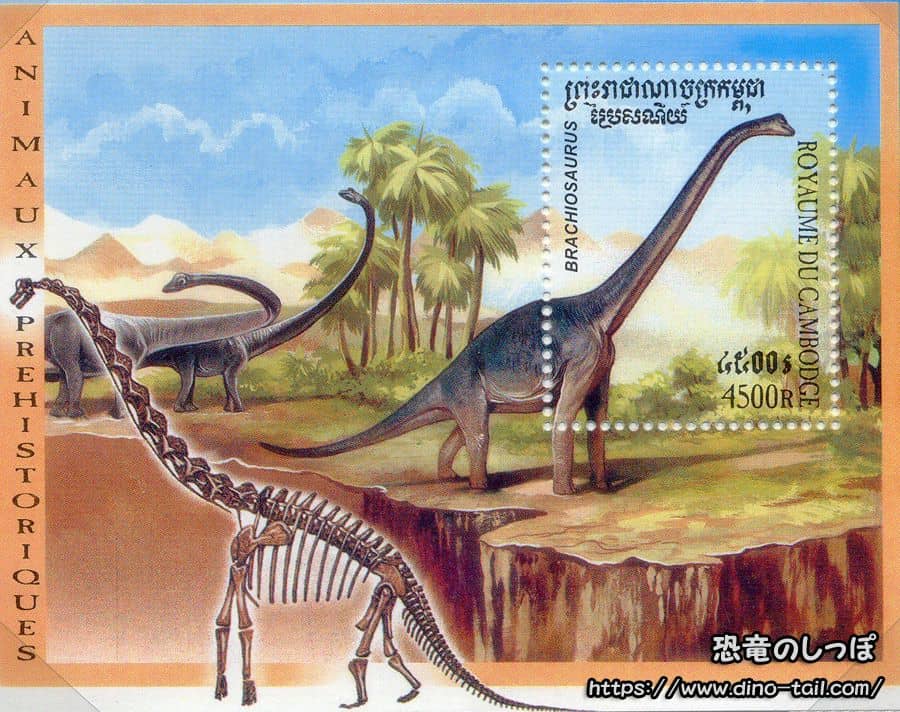
In 1900, American paleontologist Elmer S. Riggs discovered partial sauropod fossils, including a partial head, right humerus, right femur, right ilium (hip bone), right metatarsals, and sacrum, in the Morrison Formation in Colorado, USA. These are the specimens now cataloged as FMNH P 25107.
The following year, in 1901, he noted the unusual length of the humerus compared to the femur and that the tail was less developed than in other sauropods, suggesting a giraffe-like posture—forelimbs longer than hind limbs and an uplifted neck.
In 1903, Elmer S. Riggs published the paper "Brachiosaurus altithorax, the largest known dinosaur," describing Brachiosaurus as a new genus.
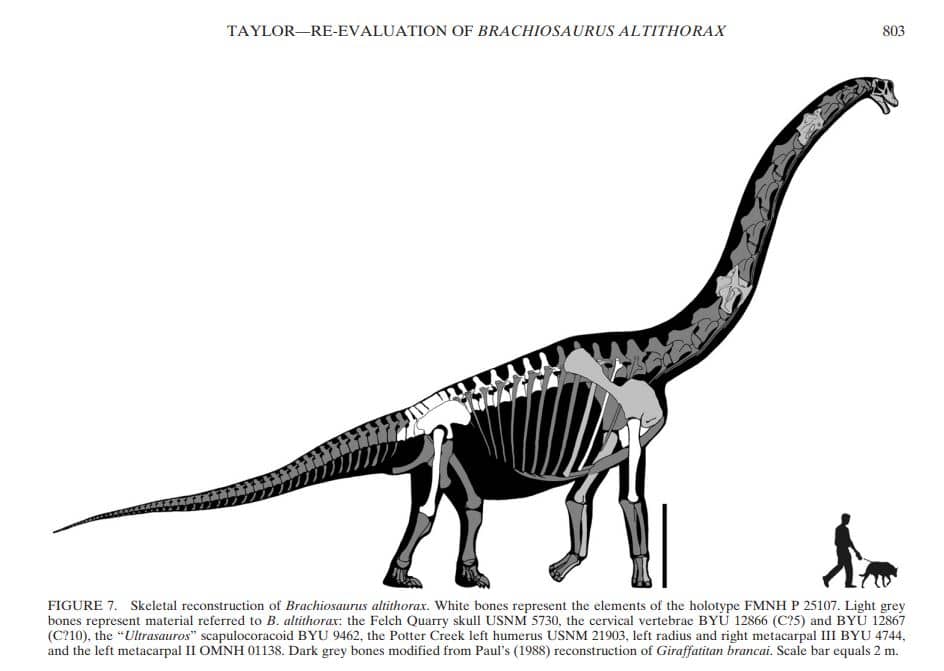
Source: Taylor, M.P. (2009). A Re-evaluation of Brachiosaurus altithorax...
From 1909-1912, a large quantity of sauropod fossils was excavated from the Tendaguru Formation in Tanzania, East Africa. German paleontologist Werner Janensch listed the differences and similarities with Brachiosaurus altithorax and, in 1914, described it as a new species, Brachiosaurus brancai (B. brancai).
However, Brachiosaurus brancai would later be reclassified into a separate genus. In 1988, Gregory S. Paul pointed out differences in the vertebral shapes of B. altithorax and B. brancai. In 1998, a comparison with a Brachiosaurus skull from the North American Morrison Formation revealed even more differing elements in B. brancai. In 2009, Michael P. Taylor argued that brancai should be included in the genus Giraffatitan at the genus level. (Giraffatitan is included in the Brachiosauridae family).
The original Brachiosaurus genus (from North America) is said to have had a longer torso, a less steep slope at the base of the neck, and a more modest head crest compared to Giraffatitan (from Africa). Giraffatitan had a body shape more like a giraffe, with a more vertically oriented neck.
At the Natural History Museum in Berlin, famous for its dinosaur hall, the specimen once displayed as Brachiosaurus is now displayed as Giraffatitan. Specimens seen at mineral shows labeled as "Brachiosaurus from Tanzania (Tendaguru Formation)" are more accurately considered to be of the genus Giraffatitan, not Brachiosaurus.
